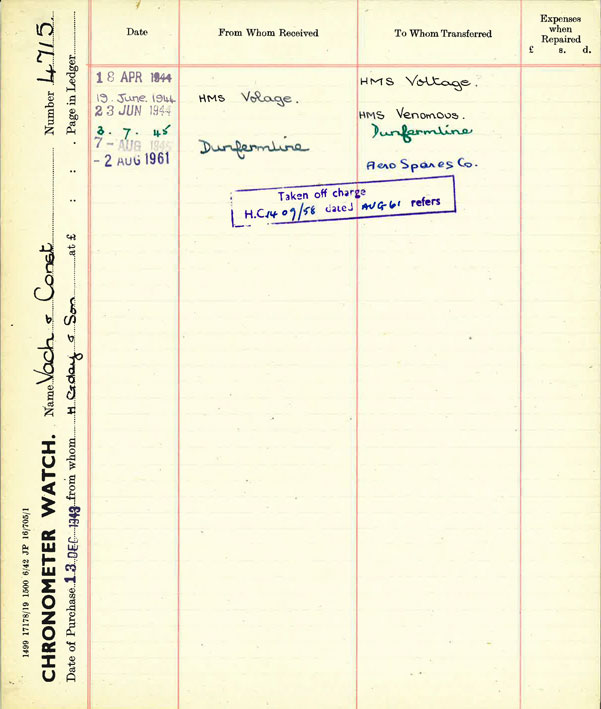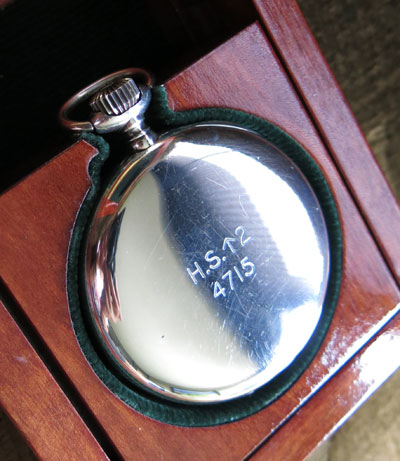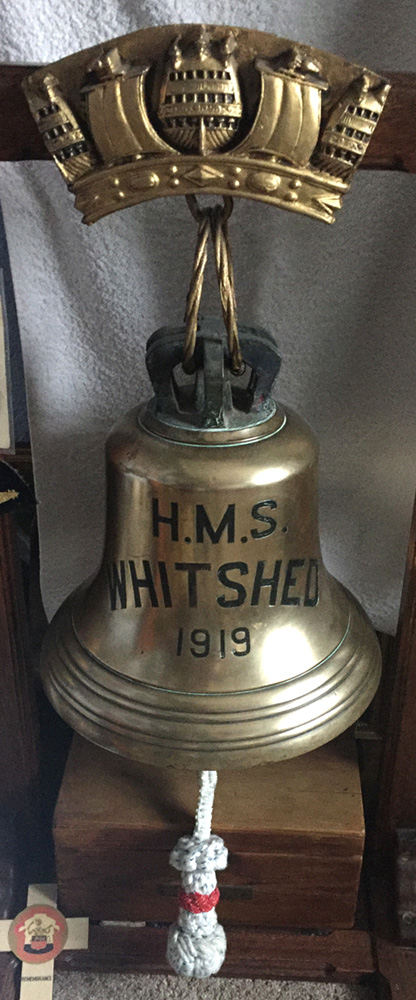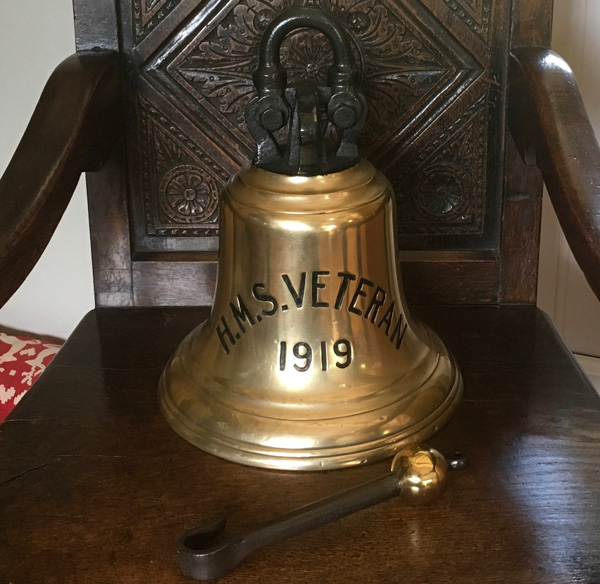The lives of every officer and rating in a ship was determined by ship's time struck every half hour on the ship's bell and
by his "Watch". His Watch told him where he had to be at any time and
the bell told him the time aboard ship. The ship's bell has naturally
become the most collectable item aboard ship and I have been sent
photographs of many of the bells issued to V & W Class
destroyers. The United States Navy retains the ownership of the
bells of all major combatant vessels but in the Royal Navy Ships'
bells were offered for sale by the Admiralty when no longer required
and there is no central record of who owns them now.
Most are in private hands and since they are so collectable and command
high prices there are many fakes and I thought it would be helpful to
pass on what little I know via this web page and appeal to you and
others to send me photographs of the bells of V & W Class
destroyers known to you and any information or advice that may be of
help in distinguishing between replica bells or fakes and the
originals.
But before doing so I think it would be best to start by explaining the
meaning of ship's time and the organisation of the ship into four
hour "Watches" with the striking of the time on the ship's bell at half hour intervals and
the difference between the two watches kept in port and the three
watches kept at sea on cruising stations and "action stations" when
every man is on duty.
***************
Time
Ship's time is unrelated to local time which varies according to
longitude. It is based on the 24 hour clock and is divided into 4 x
four hour watches, beginning with the "Middle Watch" at midnight GMT
(0000), followed by the first and last "dog watch" of two hours each,
and ending at 2400 with a seventh four hour Watch, confusingly called
the First Watch.
This table from the
Seamanship Manual (1951) may make things clearer:
WATCH
| NAVAL TIME
| CIVIL TIME
|
Middle
| 000 - 0400
| Midnight - 4 am
|
Morning
| 0400 - 0800
| 4 am - 8 am
|
Forenoon
| 0800 - 1200
| 8 am - noon
|
Afternoon
| 1200 - 1600
| noon - 4 pm
|
First Dog
| 1600 - 1800
| 4 - 6 pm
|
Last Dog
| 1800 - 2000
| 6 - 8 pm
|
First
| 2000 - 2400
| 8 pm - midnight
|
From the Seamanship Manual (1951)
A portable
Ship's Chronometer carried by the Commanding Officer
checked the times displayed on the ship's clocks to see that they were
accurate and consistent. I was delighted to be sent a photograph of the
Chronometer of HMS
Venomous,
the V & W Class destroyer in which my father served as Lt(E) during
her final Commission before she went to the Breaker's yard in 1948.
The front and reverse of the ...
Note the identifier HS 4715 on the reverse
Lt(E) William Redvers Forster RNR was the only officer aboard by 1946
and, technically, the Commanding Officer, though in practice, no more
than a caretaker. The documentation records that the chronometer was in
Venomous from 23 June 1944 - 1945.
Striking the Ship's Bell
The time was given by striking the hours and half-hours on the
ship's bell throughout each watch, "one bell",
"two bells", etc according to the number of itmes the bell has been
struck. The sequence is repeated in each watch and the name of the
watch is added to tell the time e.g. 10.30 civil time would be "five
bells in the forenoon". The last dog-watch ends at 2000 with eight
bells.
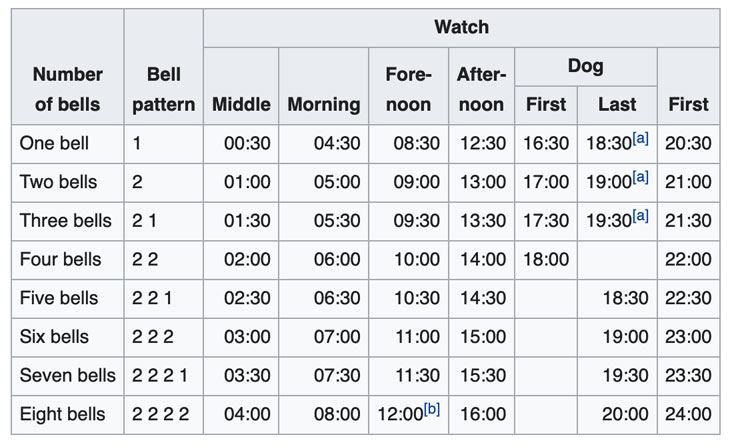 From Wikipedia: https://en.wikipedia.org/wiki/Ship's_bell
From Wikipedia: https://en.wikipedia.org/wiki/Ship's_bell
The "dog watch" was divided in two to give each man a different
watch each day; it also allowed the entire crew of a vessel to eat an
evening meal, the normal time being at 17:00 with first dog watchmen
eating at 18:00.
Apart from marking the time the bell is only struck in fog or bad
weather, when it is rapidly run for five seconds every minute, and for
a general alarm ordered by the Commanding Officer when it is rung
rapidly for much longer than five seconds.
Watches
In Port
Port and Starboard Watches were kept in Port, either 24 hours on and 24
hours off, or 12 hours on and 12 hours off, allowing men to go ashore on
a day's leave, or half the crew to be sent on leave for a week while
the other watch manned the ship, sometimes while a boiler clean was
carried out.
At anchor, the state of the weather might require a higher degree of
readiness, with an Anchor Watch being kept on the bridge, and possibly
main engines being brought to short notice.
At Sea
In wartime the normal state for warships was the two watch system,
Defence Stations:
one watch on and one watch off, known as one in two. This allowed for
the ship's weapons systems to be ready for immediate use, and for
damage control stations to be manned. Depending on the threat, the Ship's Company might have to go to
Action Stations, to cover the periods of low light at dawn and dusk.
Depending on the threat, a three watch system,
Cruising Stations:
one in three, might be followed, giving more time off for rest and
meals. The watches were named Red, White, and Blue. The Engineering
Department might operate in three watches as a matter of course.
Action Stations
When Action Stations was sounded on the ship's bell and over the
Tannoy, every man in the ship 'closed up' in his place, which might be
different from his station when the ship was at Defence or Cruising
Stations.
For the ship's routine, the entire
ship's company (except "Daymen" - stewards, sick-bay attendants and so
on) is divided into three watches - Red, White and Blue. The 24 hours
are also divided into watches - First (8pm to midnight), Middle
(midnight to 4 am), Morning (4 am to 8 am), Forenoon (8 am to noon),
Afternoon (noon to 4 pm), First Dog (4 pm to 6 pm), and Last Dog (6 pm
to 8 pm - and scorned is the novice who would call it Second
Dog!). These spells of duty are kept by the watches in rotation;
that is the reason for the two short Dog Watches, ensuring an uneven
number of watches in the 24 hours and so arranging that Red,
White and Blue keep a different "trick" each day. In wartime the Duty
Watch is "closed up" at the armament while ... the other two watches
are industriously engaged in routine duties invented with equal
industry by the Petty Officers of the Watch.
... the transverse divisions of the
ship's company into three watches (Red, White and Blue) for ordinary
routine, into two watches (Port and Starboard) for leave and larger
administation, into three divisions (forecastle, iron-deck and
quarterdeck) for the working of the ship and allocation to "Divisional
Officers", and into eight teams or messes for living arrangements,
mixed us all up into different groups at different times and made the
arrangement of a chosen social life as difficult at sea as it is
anywhere else.

 SHIPS' BELLS
SHIPS' BELLS
